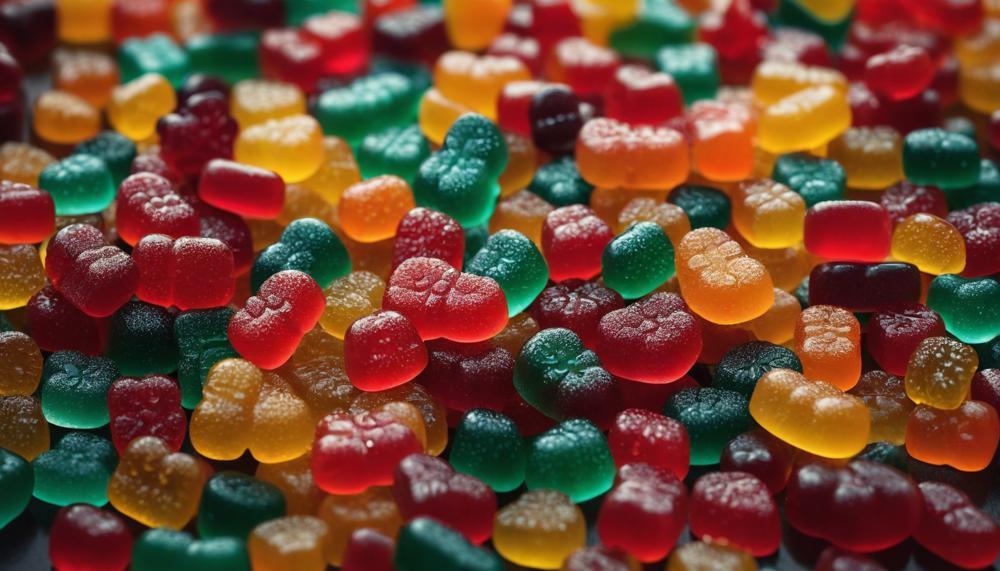Ever wondered what happens if you munch on expired gummies? It might not seem like a big deal, but eating expired gummies can lead to some surprising consequences.
Expired gummies don’t just lose their flavor and texture; they can also pose some health risks. Here’s a quick rundown of what to expect:
- Loss of Potency: If your gummies are infused with vitamins or cannabis, expect them to lose their effectiveness over time.
- Texture and Taste Changes: Expired gummies might become hard, sticky, or develop an off-taste.
- Potential for Mold Growth: Old gummies can become a breeding ground for mold, which can lead to digestive issues.
- Reduced Nutritional Value: For vitamin gummies, expired ones won’t provide the same health benefits as fresh ones.
- Digestive Issues: Consuming expired gummies might lead to stomach upset, nausea, or other digestive discomforts.
Eating expired gummies isn’t usually life-threatening, but it’s certainly not advisable. Always check the expiration date and store your gummies properly to enjoy them at their best. Curious about the details? Read on to learn more.
Contents
- 1 Do Edible Gummies Expire?
- 2 How Long do Edibles Last and Stay Fresh?
- 3 Signs that Edibles Have Gone Bad
- 4 Is the Shelf Life of Edible Gummies Similar to Regular Food?
- 5 Do Edibles Lose Potency Over Time?
- 6 Cannabis Edibles Storage Tips
- 7 Consider Best-Before Dates
- 8 Best Edibles with Long Shelf Life
- 9 Conclusion
Do Edible Gummies Expire?
Yes, edible gummies do expire. Understanding the shelf life and storage methods is vital to ensure their safety and effectiveness.
Shelf Life and Storage:
Edible gummies typically last between three to six months when stored properly. Here’s a breakdown:
| Storage Condition | Shelf Life | Details |
| Airtight Container | 3-6 Months | Maintains freshness and prevents contamination |
| Refrigerated | Up to 9 Months | Prolongs shelf life by slowing down degradation |
| Room Temperature | 1-3 Months | Shorter shelf life due to exposure to heat and light |
Factors Affecting Shelf Life:
- Ingredients: Natural preservatives like citric acid and sugar extend shelf life, but gummies still degrade over time.
- THC/CBD Degradation: The potency of active ingredients like THC and CBD diminishes over time, resulting in less effective edibles.
- Contamination: Exposure to air and moisture can introduce bacteria and mold, making gummies unsafe to consume.
Signs of Expiry:
- Texture Change: Gummies becoming hard, sticky, or discolored indicate they have expired.
- Odor: A sour or off smell is a sign of spoilage.
- Taste: A change in taste can signal that the gummies are no longer good.
Best Practices for Storage:
- Keep Them Cool: Store in a cool, dark place away from direct sunlight.
- Use Airtight Containers: Prevents exposure to air and moisture.
- Check Best-Before Dates: Always observe the manufacturer’s best-before date for optimal freshness and potency.
How Long do Edibles Last and Stay Fresh?
Edibles typically last between 3 to 6 months under optimal conditions. However, the exact duration depends on several factors including storage, ingredients, and the type of edible.
Factors Influencing Shelf Life:
Storage Conditions:
- Temperature: Keep edibles in a cool, dark place to maintain freshness. Refrigeration can extend their life.
- Airtight Containers: Use these to prevent exposure to air and moisture, which can hasten spoilage.
Ingredients:
- Preservatives: Edibles with preservatives last longer than those without.
- Perishables: Edibles containing dairy or fresh fruit spoil faster.
THC/CBD Degradation:
- Light and Air Exposure: These degrade cannabinoids, reducing potency over time.
Storage Tips:

- Refrigerate: Especially for gummies and baked goods.
- Freeze: For longer-term storage, particularly if they contain perishables.
- Check for Signs of Expiry: Changes in texture, off smells, or mold indicate that edibles are no longer safe to consume.
| Type of Edible | Shelf Life (Optimal Conditions) | Storage Recommendations |
| Gummies | 3-6 months | Airtight container, refrigerate |
| Baked Goods | 1-2 weeks | Airtight container, refrigerate or freeze |
| Chocolates | 6 months | Cool, dark place; refrigerate if warm |
Signs that Edibles Have Gone Bad
Recognizing the signs that your edibles, like gummies, have gone bad is essential for ensuring safety and avoiding unpleasant experiences. Here are some common indicators:
| Signs | Description | Explanation |
| Visible Mold | Presence of white, green, or black spots on the gummies. | This is a clear sign of fungal growth, making the edibles unsafe to consume. |
| Off Smell | A sour, rancid, or unusual odor emanating from the gummies. | Edibles should generally smell sweet or fruity; any off smells indicate spoilage. |
| Change in Texture | Gummies become excessively hard, sticky, or slimy. | Properly stored gummies should retain their chewy texture. Changes indicate degradation. |
| Discoloration | Faded colors or unusual dark patches on the gummies. | Fresh gummies maintain their vibrant colors; discoloration can be a sign of spoilage. |
| Unusual Taste | A bitter, sour, or otherwise off taste when consumed. | Any deviation from the expected flavor is a sign the gummies have gone bad. |
| Expiration Date | Past the labeled expiry date on the packaging. | Consuming edibles beyond their expiration date increases the risk of spoilage and potency loss. |
| Packaging Integrity | Damaged or compromised packaging. | Proper packaging helps preserve freshness. Any damage can lead to contamination. |
Is the Shelf Life of Edible Gummies Similar to Regular Food?
No, the shelf life of edible gummies is not similar to regular food.
Edible gummies generally have a longer shelf life compared to most regular foods. This longevity is due to their unique ingredients and the presence of natural preservatives.
Ingredients:
- Sugar: Acts as a preservative by reducing the water activity in gummies, which inhibits the growth of microorganisms.
- Citric Acid: Serves as an additional preservative, contributing to the extended shelf life.
Shelf Life:
- Edible Gummies: Typically last between 3 to 6 months when stored properly in airtight containers, away from moisture and contaminants.
- Regular Food: The shelf life varies widely. Fresh produce, dairy, and baked goods spoil much faster, often within a few days to a week, even under optimal conditions.
Storage:
- Optimal Conditions: To maximize the shelf life of gummies, they should be kept in airtight containers, away from light and heat. This prevents exposure to germs and moisture, which can lead to spoilage.
Here’s a comparison table for better understanding:
| Category | Edible Gummies | Regular Food |
| Typical Shelf Life | 3 to 6 months | Varies widely (few days to weeks) |
| Key Ingredients | Sugar, Gelatin, Citric Acid, Cannabis Resin Oil | Varies (e.g., vegetables, dairy, grains) |
| Storage Requirements | Airtight containers, cool and dry place | Varies (refrigeration, dry storage) |
| Preservatives | Sugar, Citric Acid | Varies (often none for fresh produce) |
Do Edibles Lose Potency Over Time?
Yes, edibles do lose potency over time. This is primarily due to the degradation of cannabinoids, which are sensitive to factors like temperature, humidity, and light.
Although lab testing has indicated that THC levels in edibles may remain stable up to a year past the “best by” date, these conditions can still significantly impact the overall potency and effectiveness of the product.
To better understand how different factors affect the potency of edibles, consider the following:
| Factor | Impact | Explanation |
| Temperature | High temperatures accelerate degradation | Exposure to heat can cause cannabinoids like THC to break down more quickly, reducing potency. |
| Humidity | Promotes mold and degradation | Moisture can lead to the growth of mold and mildew, as well as degrade the quality of the edibles, diminishing their effectiveness. |
| Light | Causes cannabinoid breakdown | UV light can break down cannabinoids over time, which leads to a reduction in potency. |
Storage Recommendations:
- Airtight Containers: Store edibles in airtight containers to protect them from air and moisture.
- Cool, Dark Places: Keep them in cool, dark places to minimize exposure to light and heat. A pantry or cupboard is ideal.
- Refrigeration: For extended shelf life, especially with gummy edibles, refrigeration can be beneficial.
Gummy Edibles: Gummy edibles are known for their longer shelf life, as ingredients like sugar and citric acid act as preservatives. When stored properly, these can last between 3 to 6 months without significant loss of potency.
Cannabis Edibles Storage Tips
Proper storage of cannabis edibles is essential to maintaining their potency and safety over time. Here are some key practices to ensure your edibles remain effective and safe to consume:
Use Airtight Containers
Store your edibles in airtight containers to prevent exposure to air, which can degrade the cannabinoids. This keeps the edibles fresh and potent.
| Container Type | Purpose | Examples |
| Glass Jars | Preserve freshness and prevent odour leakage | Mason jars, vacuum-sealed jars |
| Plastic Containers | Convenient for everyday use and travel | Tupperware, BPA-free containers |
| Silicone Bags | Flexible, reusable, and airtight | Stasher bags |
Store in a Cool, Dark Place
Light and heat can cause cannabinoids to degrade. Storing edibles in a cool, dark place such as a pantry or cupboard helps preserve their potency.
Refrigeration and Freezing
For longer-term storage, use refrigerator or freezer-safe containers. Freezing edibles can significantly extend their shelf life without compromising potency.
“Freezing cannabis edibles can effectively preserve their potency and prevent spoilage, ensuring they remain safe for consumption over extended periods.” – TIPA Corp
Separation from Non-Infused Treats
Keep cannabis edibles separate from non-infused treats to avoid confusion and accidental consumption. Label containers clearly to identify the contents.
Monitor Shelf Life
Be mindful of the best-before dates on edibles. Consuming expired edibles can lead to reduced potency and potential safety risks.
“Proper storage practices can help ensure your cannabis edibles remain effective and safe to consume, preventing degradation and spoilage.” – Herb.co
By following these storage tips, you can maintain the quality and potency of your cannabis edibles, ensuring a safe and enjoyable experience every time.
Consider Best-Before Dates
Best-before dates on food products, especially gummies, are vital for indicating the optimal quality and freshness period. Unlike use-by dates, which relate to food safety, best-before dates provide a timeline during which the product is expected to maintain its best flavour, texture, and nutritional value.
For gummies, best-before dates are particularly significant for several reasons:
- Texture and Freshness: Gummies can become hard and lose their chewy texture after the best-before date. This change can affect the overall enjoyment of the product.
- Flavour Degradation: Over time, the flavours in gummies can deteriorate, resulting in a less pleasant taste experience. This is especially important for fruit-flavoured or sour gummies, where flavour intensity is key.
- Nutritional Quality: Some gummies, especially those fortified with vitamins, may lose their nutritional potency after the best-before date. Vitamins can degrade, making the gummies less effective as a dietary supplement.
- Shelf Life and Storage: Proper storage conditions, such as keeping gummies in a cool, dry place, can extend their freshness even after the best-before date. However, once this date is surpassed, the likelihood of changes in quality increases.
| Aspect | Before Best-Before Date | After Best-Before Date |
| Texture | Chewy and soft | Hard and possibly sticky |
| Flavour | Strong and vibrant | Weakened, less intense |
| Nutritional Quality | High, especially for fortified gummies | Decreased nutritional value |
Note: Although gummies may still be safe to consume past their best-before date, their quality will not be at its peak. For best results, always check for any signs of spoilage or significant changes in appearance and texture before consumption.
Best Edibles with Long Shelf Life
Several edibles stand out for their long shelf life and suitability for storage. These items, if stored correctly, can maintain their quality for years, providing reliable sustenance in various situations.
Examples of Edibles with Long Shelf Life
Dried Beans
Dried beans, such as black beans, lentils, and chickpeas, are renowned for their durability. When stored in a cool, dry place, they can last up to 10 years. They are also a great source of protein and fiber, making them a nutritious choice for long-term storage.
| Food Item | Shelf Life | Storage Tips |
| Dried Beans | Up to 10 years | Store in airtight containers in a cool, dry place |
White Rice
White rice is another staple with an impressive shelf life. If kept in airtight containers and stored in a cool, dry place, it can remain edible for up to 30 years. It’s a versatile food that can be used in various dishes.
| White Rice | Up to 30 years | Use airtight containers and keep in a cool, dry place |
Honey
Honey is famous for its indefinite shelf life. Due to its natural composition, it doesn’t spoil and can be stored for decades. Ensure it’s kept in a sealed container at room temperature to maintain its quality.
| Honey | Indefinite | Store in a sealed container at room temperature |
Canned Goods
Canned vegetables, fruits, and meats are excellent for long-term storage. These items typically last up to 5 years or more when stored properly. Cans should be kept in a cool, dry place and checked periodically for any signs of damage or spoilage.
| Canned Goods | Up to 5 years | Keep in a cool, dry place and inspect for damage |
Salt
Salt has an unlimited shelf life when stored correctly. It’s an essential seasoning and preservative that can be stored indefinitely in a dry, airtight container.
| Salt | Indefinite | Store in a dry, airtight container |
Pasta
Dried pasta can last up to 2 years beyond its “best by” date if stored in a dry, airtight container. It is a versatile and filling staple that can be paired with various sauces and ingredients.
| Pasta | Up to 2 years | Store in a dry, airtight container |
These edibles not only ensure a lasting supply but also provide essential nutrients. Proper storage conditions, such as keeping food in cool, dry, and dark places, are crucial to maximize their shelf life.
Conclusion
Eating expired gummies might not seem like a big deal, but it can lead to some unexpected consequences. These treats can lose their flavor and texture, become less potent, and even pose health risks.
First, the potency of vitamins or cannabis-infused gummies diminishes over time, making them less effective. Additionally, expired gummies often become hard, sticky, or develop an unpleasant taste, detracting from the enjoyable experience they’re meant to provide.
A significant concern with expired gummies is the potential for mold growth, which can cause digestive issues. Consuming moldy gummies could lead to stomach upset, nausea, or other discomforts, turning a simple snack into an uncomfortable ordeal. Furthermore, expired vitamin gummies lose their nutritional value, meaning they won’t offer the health benefits you’re looking for.
The shelf life of gummies varies based on storage conditions. When stored in airtight containers, they can last 3-6 months, or up to 9 months if refrigerated. However, exposure to air and moisture can speed up degradation and contamination.
To ensure your gummies stay fresh and safe, store them in cool, dark places, and always check for signs of spoilage like texture changes, off smells, or discoloration.




